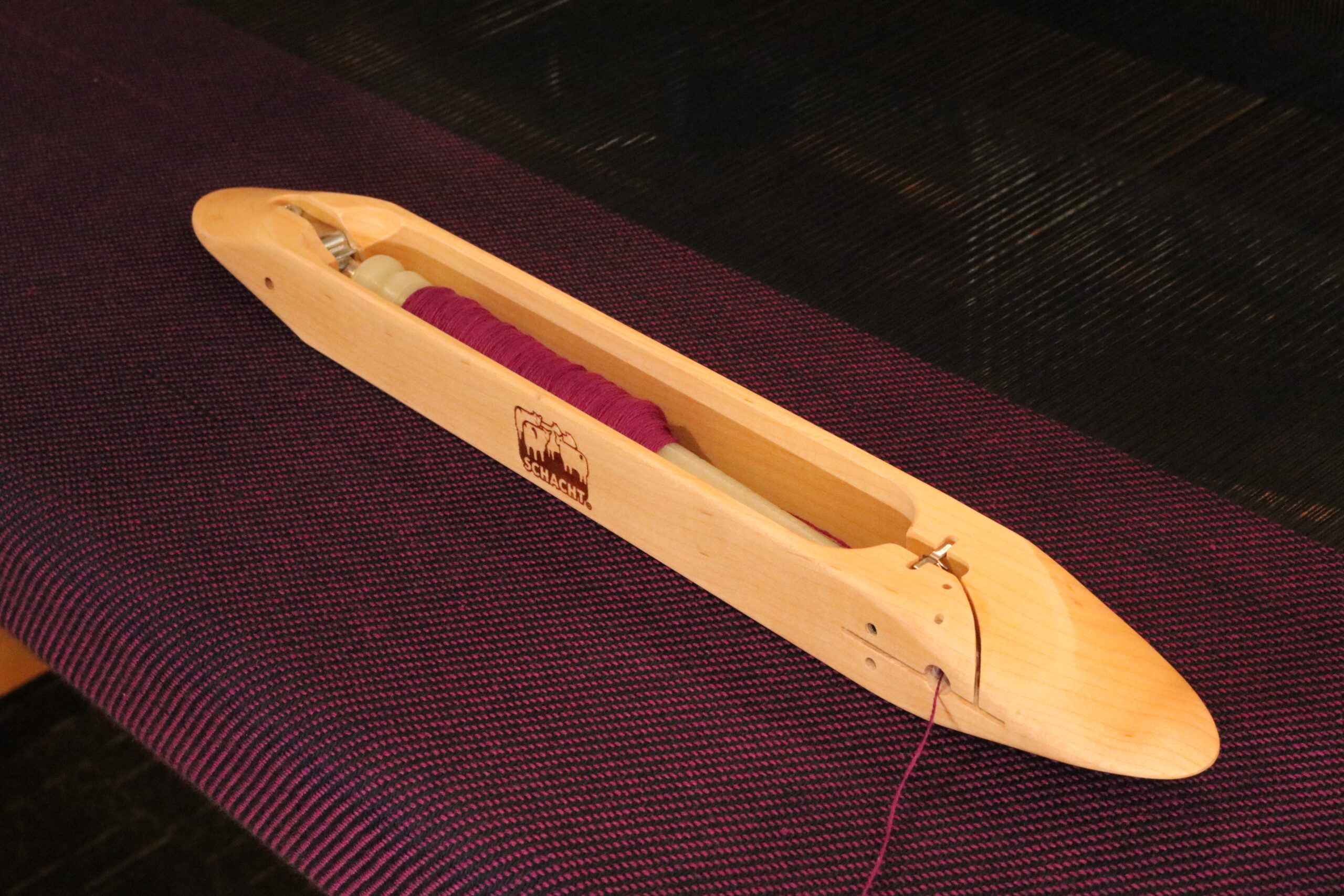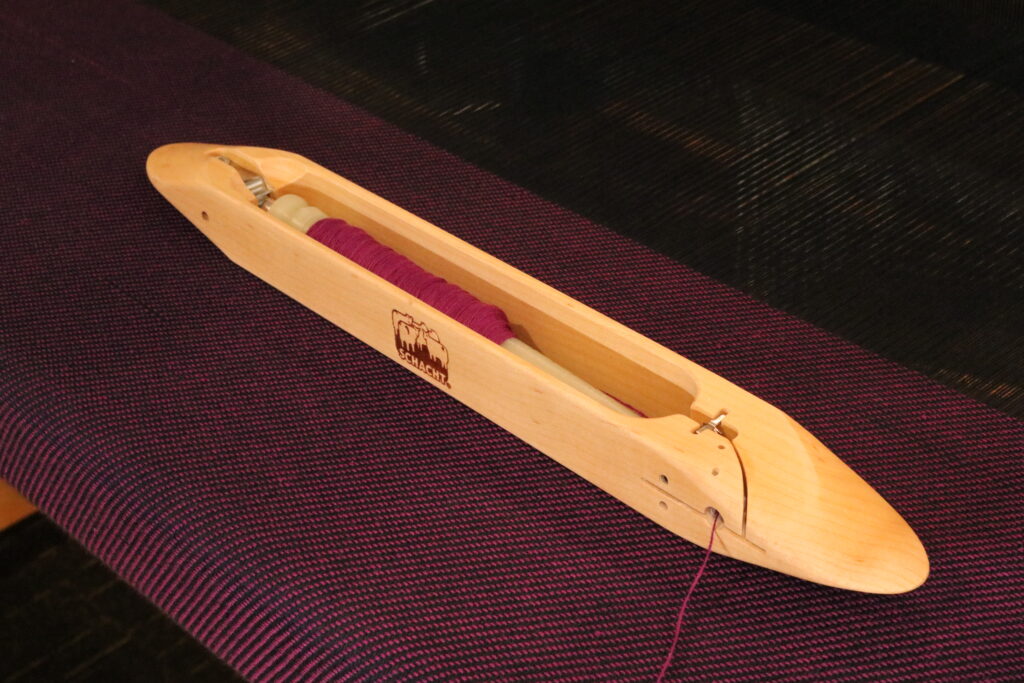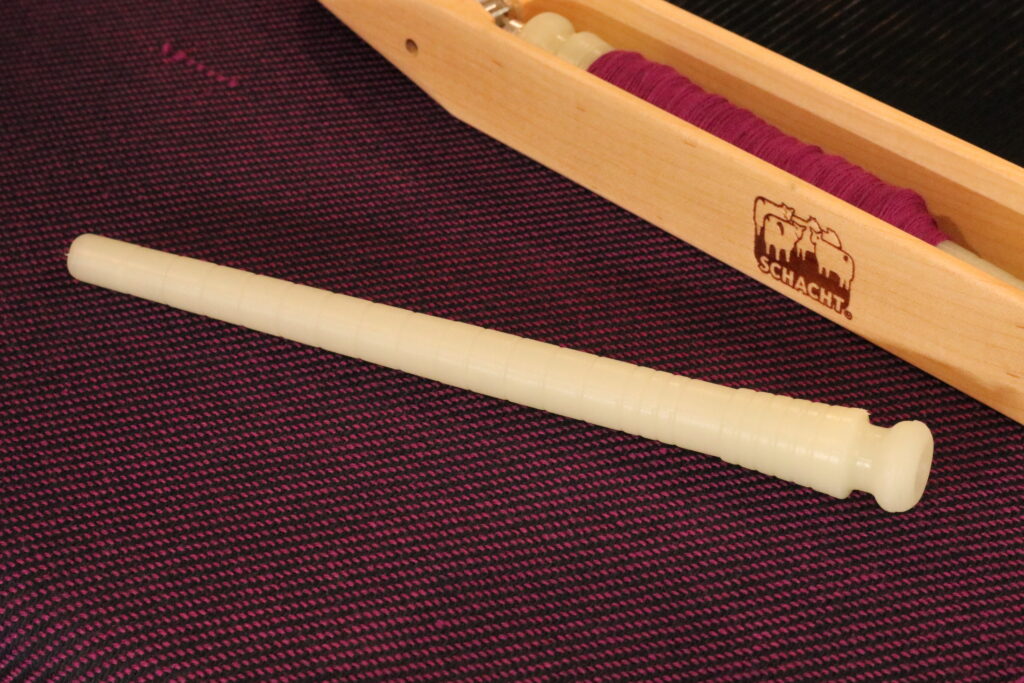The world of boat shuttles is a vast one, with lots of choices to suit your weaving situation. Today’s Ask Kelly question is about the differences between bobbins and quills used for boat shuttles.
Pictured above – Schacht end feed shuttle (requires pirns).
“Hi Kelly, I was wondering if you could explain the difference between a quill and a bobbin- I have my heart set on using a boat shuttle, finally purchased one only to find that with the bobbin the shuttle I bought, is to high to go through the shed (rigid heddle loom). I found some low profile boat shuttles, however, many of them say they take quills- so- I come to you to find out the difference and if you know of any low profile boat shuttles that take bobbins.
Thanks, Cindy.”
Pictured above – Ashford boat shuttle (requires bobbins).
Hi Cindy,
That is disappointing about your boat shuttle!
The main differences between quills and bobbins are:
- Quills are made usually of paper or cardboard, bobbins are generally hard plastic.
- Quills are smaller, lightweight and noiseless. You will usually see low profile shuttles require quills, as bobbins are too big for the lower width.
- Quills are so named because originally quills from feathers were used to load up yarn in the shuttle.
- You can either purchase quills or make them yourself, which makes them a great lower budget option. Usually when you purchase a new boat shuttle online, there will be information included as to what kind of bobbin or quill you need. Even if you’re buying a shuttle second hand, you can google the shuttle type to find out those extra details.
Pirns were not mentioned in the original question, but they are definitely worth noting here too, because again, they are another way of loading some boat shuttles.
A pirn will usually be used with an end feed shuttle and is generally made of wood or plastic. It is long and tapered, so it looks different to both bobbins and quills.
Loading a pirn with your weft thread is not done in the same way as a bobbin or quill. Bobbins are quite simple to load and can be done with either a manual or electric bobbin winder or even an electric drill (I have a video that demonstrates how to do that here) for super fast loading!
Loading a bobbin is a back and forth action, moving from one end of the bobbin to the other as it rotates.
A pirn, on the other hand needs to be started from the larger end and wound in little bouts and repeats. It’s hard to explain without showing! It’s also best to wind a pirn with a purpose built pirn winder (I wish I had one of those!) which holds the pirn at both ends, holding it very steady, but also leaving you with one hand free to tension the yarn as it winds on (which is another difference – a pirn needs very firm tensioning as it’s wound).
I hope this post has helped to clarify bobbins and quills for you. If you have a question you would like to see in a future Ask Kelly post, leave it in the comments section or feel free to email me directly.
If you would like some further resources on boat shuttles in general, have a look at these resources:
Can I use a boat shuttle with my rigid heddle loom?..
*This post contains affiliate links. For further information, please see my disclosure policy.





What are the differences/advantages of an open bottom boat and a close bottom boat shuttle?
The 2 main differences are in weight and glideability (I think I just made that word up!)
A closed bottom will allow a shuttle to glide more easily across the warp (particularly useful for a wide warp on a well tensioned loom, like a floor loom) but it also adds extra weight (doesn’t have to be a negative, just depends how you’re using it).
The video on boat shuttles was very helpful. I was wondering if I should get one for my rigid heddle loom. At this stage I don’t think so at least not yet. I’m still working with thicker threads. I’m a beginner so I think it would be wise to work out the kinks and learn more techniques before going to a finer yarn. Your YouTube demos are wonderful. I do plan to join your classes but I don’t have the funds at the moment. I’m itching to try using pick up sticks for different weaves. I watched the videos on the concept of how the warp threads are separated but I’m still unclear how it works. My husband made me some lovely pick up sticks. I turn 64 in Oct. I started weaving just a few months ago and have produced several pieces and have tried clasped weft for 2 & 3 colors. I’m currently making a table cloth for my dining room table. My loom is 24″ so I’m weaving 3 panels to sew together. I love to learn. I’ve always wanted to weave even as a little girl. I learned knitting & Crocheting at age 8 from my grandmother. Loved art in school. My family is of Mexican heritage so we always had colorful wool woven Sarapes in our home as table runners & blankets. I always would think, ” How did they do this?” Latin American textiles are so vibrant. Finall, after retiring, I am fulfilling my goal of learning to weave. I’ve always been a craft person and have enjoyed the pursuit of many types of art. Weaving fulfills a special place & I really want to get good at it.
The great thing is that you have so many options in weaving. So, if you are inspired by Mexican weaving, you will be able to find suitable yarns and use similar colours. And with the availability of weaving information online and in books these days, you can find out what you need to know, it certainly wasn’t like that when I started weaving! You may be interested in researching weft faced weaving and backstrap looms.
Hi Kelly, I use drinking straws in my boat shuttles, cut to length. I filled them on a long knitting needle inserted through the flyer supports on a spinning wheel, with some masking tape to give grip to the drive belt. Now I have an upright charkha I think I will be able to use that more easily.
Can I ask, please, that you post in black font? I find the grey almost impossible to read.
That’s a very clever workaround Heather!
Regarding the text, I don’t know if I can change it, but will have a look at settings and see if I can do anything 😊
Hi Kelly,
I just watched your video on HEM STITCHING.
WHAT IS THE NAME AND/OR MANUFACTURER OF THE GOLD CURVED NEEDLE YOU USE FOR HEMSTITCHING!
THANJS SO MUCH.
PATTY
Hi Patty,
These are the jumbo gold, bent tip tapestry needles by Clover. Here is a link if you need it-
http://amzn.to/3L4l2ea